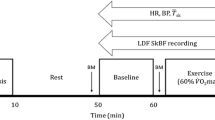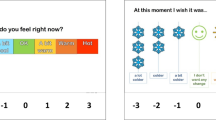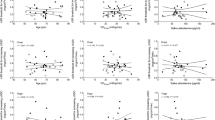Abstract
Seven prepubertal boys (aged 10–11 years)␣and eleven young men (aged 21–25 years), matched for skinfold thickness and maximal oxygen uptake (O2max) per unit of mass, cycled at an intensity of approximately 40% O2max for 45 min in a warm condition (30 °C, 45% relative humidity). During exercise no age-related differences were observed for the increases in rectal temperature (T re) and heart rate (HR), although the absolute T re and HR were significantly greater for the boys because of a higher initial baseline (P < 0.05). Total body sweating rate [181 (SEM 12) vs 245 (SEM 12) g · m−2 · 45 min−1; P < 0.002] and local sweating rates ( sw) on chest, back, and forearm were significantly lower for the boys (P < 0.001), as was metabolic heat production [203 (SEM 9) vs 276 (SEM 9) W · m−2; P < 0.01]. The lower sw in the boys was due to a lower output per activated sweat gland, even though they had a higher activated sweat gland density regardless of site. In contrast, cutaneous blood flow by laser Doppler flowmetry (LDF) in the boys was significantly greater on the chest and back, compared to the men (P < 0.003). The age-related differences in cutaneous vascular conductance (CVC) were more marked because of lower mean arterial pressure in the boys during exercise. However, forearm LDF and CVC were significantly lower for the boys (P < 0.008). No significant differences in LDF among sites were observed for the boys, whereas for the men LDF on the forearm was significantly greater than on the chest and back (P < 0.01). The boys showed lower mean skin temperatures (especially on the back and chest despite greater increments of LDF) after starting to sweat, whereas the men remained unchanged, suggesting that the heat loss on the trunk in the boys was promoted by greater increments of LDF despite lower sw, compared to the young men. It was concluded that during moderate exercise in an air temperature at 30 °C, prepubertal boys could thermoregulate as efficiently as young men by greater vasodilatation on their trunk despite lower sw. Furthermore regional differences may exist in the maturation-related modification of vasodilatation.
Similar content being viewed by others
Author information
Authors and Affiliations
Additional information
Accepted: 17 September 1996
Rights and permissions
About this article
Cite this article
Shibasaki, M., Inoue, Y., Kondo, N. et al. Thermoregulatory responses of prepubertal boys and young men during moderate exercise. Eur J Appl Physiol 75, 212–218 (1997). https://doi.org/10.1007/s004210050150
Issue Date:
DOI: https://doi.org/10.1007/s004210050150




